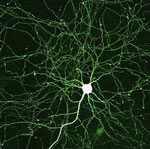 Childhood maltreatment is associated with reductions in cerebral gray matter volume, and even if adolescents reporting exposure to maltreatment do not have symptoms that meet full criteria for psychiatric disorders, they may have cerebral gray matter changes that place them at risk for behavioral difficulties, according to a report in the December issue of Archives of Pediatrics & Adolescent Medicine, one of the JAMA/Archives journals.
Childhood maltreatment is associated with reductions in cerebral gray matter volume, and even if adolescents reporting exposure to maltreatment do not have symptoms that meet full criteria for psychiatric disorders, they may have cerebral gray matter changes that place them at risk for behavioral difficulties, according to a report in the December issue of Archives of Pediatrics & Adolescent Medicine, one of the JAMA/Archives journals.
“An estimated 3.7 million children are assessed for childhood maltreatment (CM) each year in the United States; because many cases do not come to professional attention, this likely is an underestimate of the number of children experiencing maltreatment,” the authors write as background information in the article. “Converging data support adverse effects of early life stress on morphologic development of corticostriatal-limbic structures. Magnetic resonance imaging studies show decreased corticostriatal-limbic gray matter volume in children and adults reporting exposure to CM.”
Erin E. Edmiston, B.A., then of Yale University, New Haven, Conn., now with Vanderbilt University, Nashville, Tenn., and colleagues compiled data on 42 adolescents (age range 12 to 17 years) without a psychiatric diagnosis to examine the association between exposure to childhood maltreatment and cerebral gray matter volume abnormalities. Participants were recruited from a sample of children identified at birth to be at high risk for CM, and additional participants were also recruited to allow for a sample of adolescents reporting a spectrum of CM severity. Data were collected through a self-report questionnaire, and included questions related to five subtypes of CM: physical abuse, physical neglect, emotional abuse, emotional neglect, and sexual abuse.
Self-reported scores on the Childhood Trauma Questionnaire (CTQ) were associated with a negative correlation with cerebral gray matter volume in the prefrontal cortex, striatum, amygdala, sensory association cortices and cerebellum. The authors also found that self-reported physical abuse, physical neglect and emotional neglect subtypes of CM were all associated with reductions in gray matter volume of the rostral prefrontal cortex. No significant results were found for emotional abuse or for sexual abuse.
“Although preliminary, results of exploratory analyses support prominent reductions in prefrontal cortex volume common across physical abuse, physical neglect, and emotional neglect CM subtypes, as well as patterns of additional regional gray matter volume decreases in the CM subtypes,” the authors write. “Findings in girls were in regions associated with emotion regulation, whereas findings in boys were in regions subserving impulse control.”
“Together, these results highlight the critical need for improved understanding of effects of childhood abuse and neglect in adolescents and of possible differences in the effects of different CM subtypes on brain development,” the authors conclude. “Although adolescents with a history of CM may have symptoms and behaviors that may not yet meet criteria for psychiatric diagnoses, detection and early intervention may help improve functioning and reduce risk for the development of mood, addictive, and other psychiatric disorders.”
Material adapted from JAMA.
Reference
Arch Pediatr Adolesc Med. 2011;165[12]:1069-1077.
No comments yet.